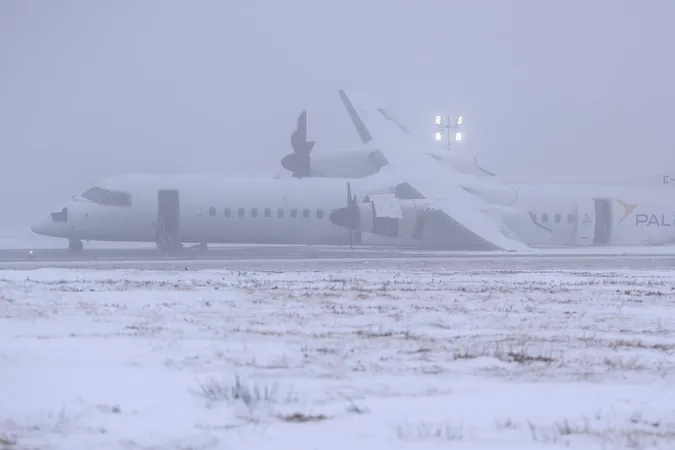
Turbulence Ahead: Investigators Scrutinize Q400 Aircraft Following Fiery Halifax Airport Incident
2025-01-07
Author: Amelia
Introduction
In a dramatic turn of events, federal investigators are currently examining a De Havilland Canada Q400 plane that made a fiery landing at Halifax airport on December 28. The focus is primarily on the aircraft's left landing gear, which reportedly collapsed during the landing, causing one of the plane’s propellers to detach and ignite flames on the runway. Fortunately, the 73 passengers and crew on board were safely evacuated without injury.
Investigation Details
The Transportation Safety Board (TSB) confirmed that their team has transported the wreckage to a secure location for further examination. Investigators have also begun interviewing the flight crew from the Air Canada Express flight operated by PAL Airlines, which had arrived from St. John’s.
History of the Q400 Model
The Q400 model has a storied history, with approximately 620 aircraft in operation worldwide. It typically accommodates around 80 passengers and is predominantly utilized by both regional and major airlines. Despite being seen as a reliable aircraft, experts have noted that the Q400 has a troubled track record, particularly related to its landing gear.
Past Landing Gear Issues
Remarkably, landing gear issues have plagued the Q400 for nearly two decades, especially highlighted by a string of three distinct crashes in Scandinavia in 2007 due to gear malfunctions. The incidents drew attention due to legal disputes between Bombardier, which owned the De Havilland brand at the time, and Scandinavian Airlines System over liability, leading to settlements and modifications in aircraft production.
Current Response and Safety Measures
In the recent Halifax incident, De Havilland Canada is collaborating with the TSB but has refrained from speculating on the causes of the failure. Air Canada asserts it is premature to draw conclusions, emphasizing its long-standing commitment to flying the Q400 safely.
Expert Opinions
While John Arnone, a former Bombardier spokesperson, indicates that exhaustive reviews following past incidents concluded no systemic faults were found, industry experts maintain that the Q400 does exhibit a tendency for landing gear troubles.
John Cox, CEO of Safety Operating Systems, has tracked multiple landing gear incidents involving the Q400, although he asserts that these types of malfunctions typically occur during lower speed landings and have not resulted in fatalities. Notably, the Q400's main competitor, the ATR turboprop, has not experienced the same frequency of landing gear issues, although it has shown vulnerabilities related to de-icing in Canadian winters.
Jim Scott, another aviation consultant, echoed these sentiments, affirming that while the Q400 generally performs well, its recurring landing gear problems have raised concerns. The Flight Safety Foundation’s database contains over 600 recorded Q400 incidents over the past two decades, with 25 classified as landing gear failures. Fortunately, no fatalities have occurred, with most cases attributed to maintenance or minor manufacturing issues.
Safety Record of the Incident Aircraft
Interestingly, the aircraft involved in the Halifax incident had a relatively clean safety record, with only a bird strike incident in Idaho in 2019 noted in the Foundation’s database.
Conclusion and Outlook
As investigations continue, the aviation community is left contemplating whether the De Havilland Q400 will be further scrutinized for its mechanical reliability or if improvements can resolve its ongoing challenges, providing safe skies for all travelers. Stay tuned as more updates emerge from this fiery ordeal!



 Brasil (PT)
Brasil (PT)
 Canada (EN)
Canada (EN)
 Chile (ES)
Chile (ES)
 Česko (CS)
Česko (CS)
 대한민국 (KO)
대한민국 (KO)
 España (ES)
España (ES)
 France (FR)
France (FR)
 Hong Kong (EN)
Hong Kong (EN)
 Italia (IT)
Italia (IT)
 日本 (JA)
日本 (JA)
 Magyarország (HU)
Magyarország (HU)
 Norge (NO)
Norge (NO)
 Polska (PL)
Polska (PL)
 Schweiz (DE)
Schweiz (DE)
 Singapore (EN)
Singapore (EN)
 Sverige (SV)
Sverige (SV)
 Suomi (FI)
Suomi (FI)
 Türkiye (TR)
Türkiye (TR)
 الإمارات العربية المتحدة (AR)
الإمارات العربية المتحدة (AR)